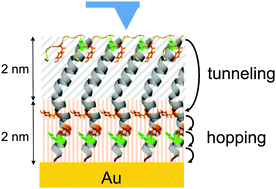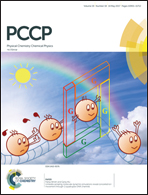Electronic characterization of Geobacter sulfurreducens pilins in self-assembled monolayers unmasks tunnelling and hopping conduction pathways
Abstract
The metal-reducing bacterium Geobacter sulfurreducens produces protein nanowires (pili) for fast discharge of respiratory electrons to extracellular electron acceptors such as iron oxides and uranium. Charge transport along the pili requires aromatic residues, which cluster once the peptide subunits (pilins) assemble keeping inter-aromic distances and geometries optimal for multistep hopping. The presence of intramolecular aromatic contacts and the predominantly α-helical conformation of the pilins has been proposed to contribute to charge transport and rectification. To test this, we self-assembled recombinant, thiolated pilins as a monolayer on gold electrodes and demonstrated their conductivity by conductive probe atomic force microscopy. The studies unmasked a crossover from exponential to weak distance dependence of conductivity and shifts in the mechanical properties of the film that are consistent with a transition from interchain tunneling in the upper, aromatic-free regions of the helices to intramolecular hopping via aromatic residues at the amino terminus. Furthermore, the mechanistic stratification effectively “doped” the pilins at the amino terminus, favoring electron flow in the direction opposite to the helix dipole. However, the effect of aromatic dopants on rectification is voltage-dependent and observed only at the low (100 mV) voltages that operate in biological systems. The results thus provide evidence for a peptide environment optimized for electron transfer at biological voltages and in the direction needed for the respiration of external electron acceptors. The implications of these results for the development of hybrid devices that harness the natural abilities of the pilins to bind and reduce metals are discussed.



 Please wait while we load your content...
Please wait while we load your content...